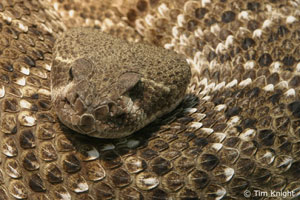


Western Diamondback Rattlesnake (Crotalus atrox) Description: Rattlesnakes are species of poisonous snakes generally called "pit vipers". The Western Diamondback can exceed seven feet in length, and is the king of our twenty odd species of Southwestern desert rattlers. The color of this striking snake ranges from brown to gray to pinkish, depending on the shade of its habitat. Its back is lined with dark diamond-shaped blotches outlined by lighter-colored scales. The spade-shaped head is distinguished by two dark stripes, one on each side of its face, which run diagonally, like Zorro’s mask. (see photo) 
This species has long, tubular fangs, which are characteristic of venomous snakes. Its tail is circled by several alternating black and white bands, like the pattern of a raccoon’s tail. The snake has "rattle" on the end of the tail that it uses as a warning sign.
Range/ Habitat: The Western Diamondback Rattlesnake ranges from central and western Texas, through southern New Mexico and Arizona, and into southern California. It also extends into central Mexico. This species is not found in Washington state. The snake occupies diverse habitats from sea level to 7,000 feet, ranging from desert flats to rocky hillsides, grassy plains, forested areas, river bottoms and coastal prairies. Click the map for information about the habitat and range of the Western Diamondback Rattlesnake in California. Diet: The Western Diamondback eats small mammals such as chipmunks, prairie dogs, gophers, ground squirrels, rabbits, mice and rats. The snake will also eat birds within reach. In a matter of seconds, rattlesnakes can leave a fatal bite by injecting venom into its prey. Sometimes the teeth break off and remain inside the prey. The fangs are replaced 2 to 4 times annually by reserve teeth. Rattlesnakes swallow their prey whole, then digest as the food passes though the body. On average, rattlesnakes in the wild eat only once every 2 to 3 weeks. Reproduction: The rattlesnake reaches sexual maturity at 3 years. Mating occurs in the spring following emergence from hibernation. The gestation period lasts for 167 days. The birthing process may last for 3 to 5 hours and produce 10 to 20 young. This species is ovoviviparous; the young pierce their thin egg membranes immediately before birth and are born live. The young only stay with the mother for a couple of hours, or for a day at the most. Then they scatter in search for food and refuge. (Animal Diversity Web) 
Behavior: The Western Diamondback often hunts at night. It ambushes victims along trails or attacks them in their burrows. Sometimes they strike and swallow an animal which weighs more than the snake. The Western Diamondback will coil, rattle fearsomely, and stand its ground when threatened. It bites hundreds of people a year, which is more than any other venomous snake in the United States. Their rattles are used as a defensive warning sign - "stay away". Rattles are a series of interlocking segments that bounce against each other to emit the rattling sound. They are hollow and made of keratin just like fingernails. Common predators of Western Diamondbacks include hawks, bald eagles, roadrunners, and wild turkeys. In the autumn, these rattlesnakes head for the community den (hibernacula) - in a cave or rocky recess - where they hibernate over the winter. Rattlesnakes can survive for several months without eating. A recent study showed that snakes can lower their metabolic rates by up to 70 percent, allowing them to survive prolonged periods without food while growing longer nonetheless.
Did you know?
More Information: Animal silhouettes available to purchase » Photo Credit: Tim Knight Home | About Us | How to Participate | Biodiversity Modules | Projects | Maps | News | Resources |